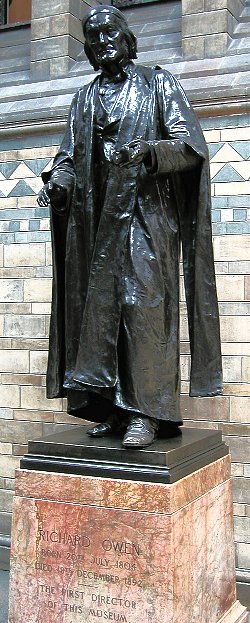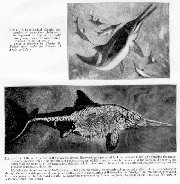Owen's Ichthyosaurus
Today, a great naturalist vanishes into Darwin's shadow. The University of Houston's College of Engineering presents this series about the machines that make our civilization run, and the people whose ingenuity created them.
Stephen Jay Gould shows us two articles in the 1838 Transactions of the Geological Society of London. The first, by Charles Darwin, is about earthworms. But it also hints at his future work on evolution. The next article is by Richard Owen. It's about a crazy kink in the tail of ichthyosaurus skeletons.
 Owen was five years older than Darwin. In 1838 he was a far more famous naturalist. In fact, young Darwin sought Owen out as a colleague. They worked together when they were young. Yet history buries Owen and exalts Darwin. And therein lies our tale.
Owen was five years older than Darwin. In 1838 he was a far more famous naturalist. In fact, young Darwin sought Owen out as a colleague. They worked together when they were young. Yet history buries Owen and exalts Darwin. And therein lies our tale.
In 1838 Darwin was just laying ground for his theory of evolution, and Owen was studying the ichthyosaurus. Young Mary Anning had dug the first whole ichthyosaurus skeleton out of the cliffs of Lyme Regis a few years earlier. The fact that its long tail abruptly bent downward had seemed unimportant.
By 1838 Owen had seen more ichthyosaurus tails. They all had that funny kink, and he set out to explain it. His insight was uncanny. His conclusion was right. Only his reasoning was off.
He argued that the tail must once have ended in a great vertical fin. The evolutionary processes that formed this beast, with its reptilian backbone, had also given it a fishlike tail. This was a reptile that swam like a fish. You see, Owen figured each time an ichthyosaurus died, that tail fin bloated with the gases of organic decay, and bloating fractured the vertebrae.
Years later, in 1890, new ichthyosaurus specimens turned up near Stuttgart. This time, the stone surrounding the bones was discolored by the original flesh. And there you could see the tail fin just as Owen had predicted. But you could also see that the backbone actually turned downward to follow the lower contour of the fin and to support it. The bones never had been broken.
A biologist recently CAT-scanned those bones, still bedded in rock. Sure enough, vertebrae in the bend are wedge-shaped -- fully evolved to negotiate the downward turn. Owen had been right about the fin. He just hadn't realized quite how efficiently ichthyosaurus had evolved to be both reptile and fish.
Owen was brilliant and difficult. He was harsh in judging other naturalists. And as Darwin grew, Owen became a casualty of the 19th-century evolution wars. He accepted Darwinian evolution, and much of his work supported it. But he could not accept the mechanism of natural selection. And he bridled at Darwin's success. In the end, Darwin's followers simply buried him.
It's ironic! Owen's life's work filled in the details of Darwin's new theory, bone by bone and species by species. At the same time those labors simply hastened his own extinction.
I'm John Lienhard, at the University of Houston, where we're interested in the way inventive minds work.
(Theme music)
Gould, S. J., Eight Little Piggies: Reflections in Natural History, New York: W.W. Norton & Co., 1993. (See especially Chapter 5, Bent Out of Shape.)
Rupke, N.A., Richard Owen: Victorian Naturalist. New Haven: Yale University Press, 1994.
See also the Encyclopaedia Britannica and Dictionary of National Biography entries on Owen as well as other writings on Owen by both Gould and Rupke. Engines Episode 863 is about Mary Anning's discovery of the first ichthyosaurus skeleton.
For more on Owen and Darwinism, see Episode 1371.
The statue of Richard Owen (above) is in the great hall of the London Natural History Museum. (Photo by John Lienhard)

Image by John Lienhard, after one in the American Museum of Natural History
The tail of an ichthyosaurus

From the 1897 Encyclopaedia Britannica
Just for the fun of it, this is Owen's drawing of another similar creature, the plesiosaurus.

(From the 1911 Encyclopaedia Britannica)
Click on the image for an enlargement.
A full ichthyosaurus skeleton and the artist's impression of the living creature